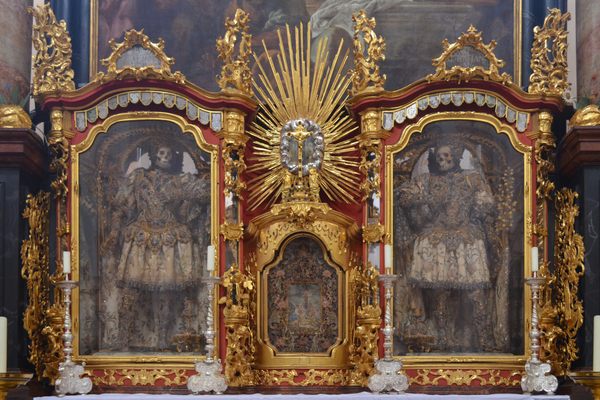The Most Beautiful Dead: Photographs of Europe’s Jeweled Skeletons
The jeweled skeleton of St. Benedictus (copyright Paul Koudounaris)
The afterlife is just more elegant for some of us. In a state of repose in churches around Germany, Switzerland, and Austria are these jeweled skeletons ornately decked out for their eternal rest. Yet despite their fascinating garb, they have been almost forgotten.
A new book coming out this October by LA-based photographer and author Paul Koudounaris — called Heavenly Bodies: Cult Treasures & Spectacular Saints from the Catacombs, published by Thames & Hudson — brings these beautiful corpses out of obscurity. Back in 2011, Koudounaris published a book on ossuaries called The Empire of Death, and here he takes a step further into the religious veneration of sacred remains.
The jeweled skeletons were originally found in catacombs beneath Rome in 1578, and distributed as replacements under the belief they were Christian martyrs to churches that had lost their saint relics in the Reformation. However, for most, their identities were not known. The receiving churches then spent years covering the revered skeletal strangers with jewels and golden clothing, even filling their eye sockets and sometimes adorning their teeth with finery. Yet when the Enlightenment came around they became a little embarrassing for the sheer amount of money and excess they represented, and many were hidden away or disappeared. Koudounaris tracked down the dead survivors.
At Atlas Obscura, we’re not unfamiliar with the beautiful dead, from the painted skulls of the Hallstatt Charnel House to elaborate wax and bones saints like Saint Vincent de Paul in Paris, but the skeletons in Heavenly Bodies take ornamentation to a new level. Here are a few from for proof, with captions from the book that give some insight into how these skeletons came to be so glamorous:
St. Valerius in Weyarn (copyright Paul Koudounaris)
The skull of St. Getreu in Ursberg, Germany, is covered in silk mesh and fine wirework set with gemstones, which may have been done in Mindelheim, Germany. (copyright Paul Koudounaris)
Detail of the hand of St. Valentin in Bad Schussenreid, Germany, one of a number of Katakombenheiligen (Roman catacombs saints) named for the popular Italian saint. (copyright Paul Koudounaris)
St. Felix, pictured here, arrived in Sursee, Switzerland, in 1761, and was decorated to match St. Irenaus, brought over a century before by Johann Rudolf Pfyffer of the papal Swiss Guard. (copyright Paul Koudounaris)
St. Munditia, in the church of St. Peter in Munich, grasps a flask supposedly containing dehydrated blood as evidence of her martyrdom. When faith in the catacomb saints waned, Munditia was boarded up and spent several decades hidden from view (copyright Paul Koudounaris)
In Stams, Austria, St. Vincentus’ ribs are exposed beneath a web of golden leaves’ the hand raised to cover the face is a gesture of modesty. (copyright Paul Koudounaris)
Decorated by the skilled lay brother Adalbart Eder, St. Valentinus in Waldsassen wears a biretta and an elaborate, elegantly jeweled version of a deacon’s cassock to emphasize his ecclesiastical status. (copyright Paul Koudounaris)
St. Friedrich at the Benedictine abbey in Melk, Austria, is presented in a typical reclining pose and holds a laurel branch as a sign of victory. (copyright Paul Koudounaris)
The arrival of St. Albertus’ remains from the Roman Catacombs in 1723 was a source of great excitement for the parishioners of the church of St. George in Burgrain, Germany, offering both a tangible connection to the early Christian martyrs and a glimpse of the heavenly treasures that awaited the faithful. (copyright Paul Koudounaris)
St. Luciana arrived at the convent in Heiligkreuztal, Germany, in the mid- 18th century and was prepared for display by the nuns in Ennetach. (copyright Paul Koudounaris)
The relic of St. Deodatus in Rheinau, Switzerland, is an example of an unusual reconstruction technique in which a wax face was moulded over the upper half of the skull and a fabric wrap used to create a mouth. (copyright Paul Koudounaris)
In addition to its four complete skeletons, the church in Roggenburg, Germany, owns a pair of skull relics. This one was given the generic name of Deodatus as its identity was unknown. (copyright Paul Koudounaris)
Heavenly Bodies Cult Treasures & Spectacular Saints from the Catacombs by Paul Koudounaris is available October 8, 2013 from Thames & Hudson.





Follow us on Twitter to get the latest on the world's hidden wonders.
Like us on Facebook to get the latest on the world's hidden wonders.
Follow us on Twitter Like us on Facebook